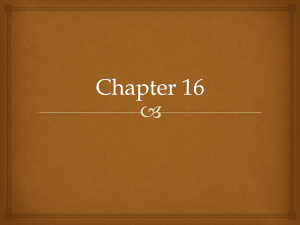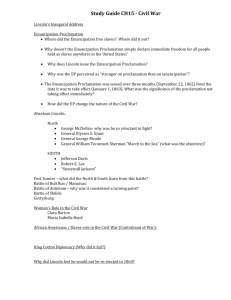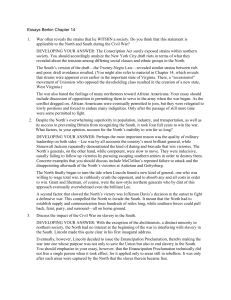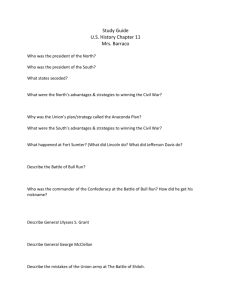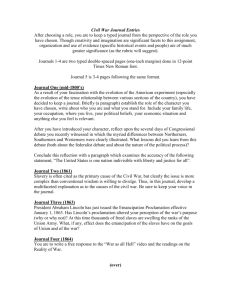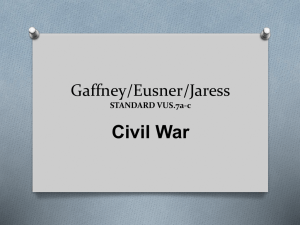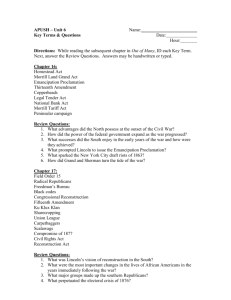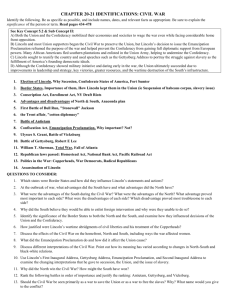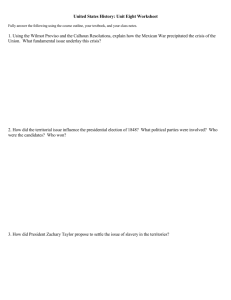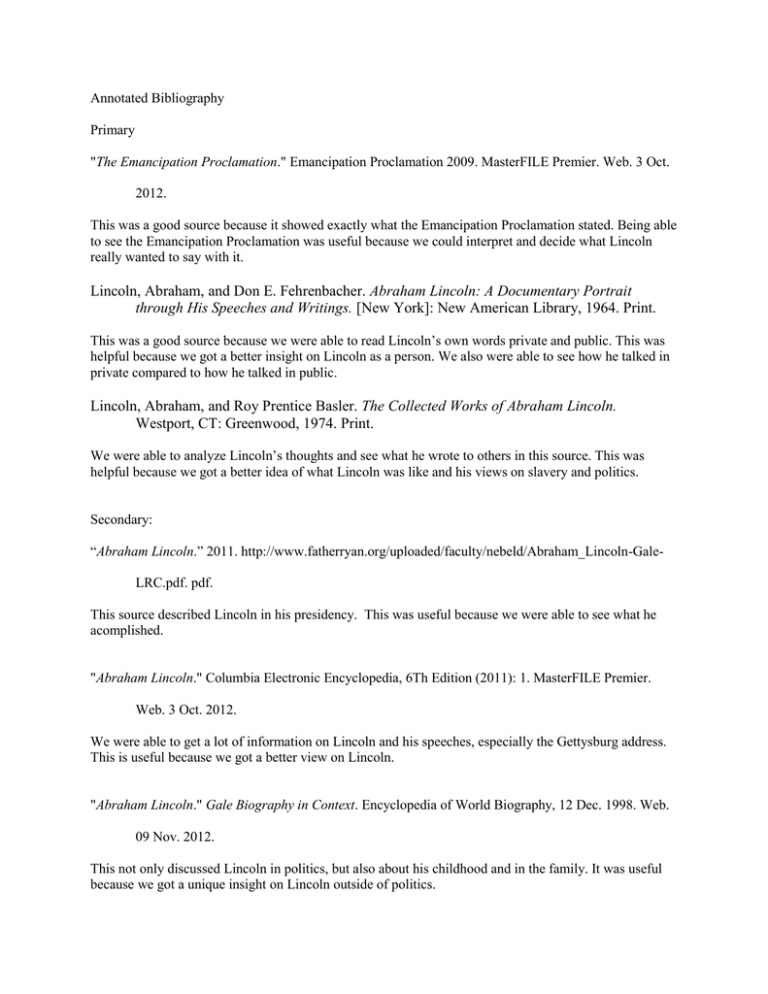
Annotated Bibliography
Primary
"The Emancipation Proclamation." Emancipation Proclamation 2009. MasterFILE Premier. Web. 3 Oct.
2012.
This was a good source because it showed exactly what the Emancipation Proclamation stated. Being able
to see the Emancipation Proclamation was useful because we could interpret and decide what Lincoln
really wanted to say with it.
Lincoln, Abraham, and Don E. Fehrenbacher. Abraham Lincoln: A Documentary Portrait
through His Speeches and Writings. [New York]: New American Library, 1964. Print.
This was a good source because we were able to read Lincoln’s own words private and public. This was
helpful because we got a better insight on Lincoln as a person. We also were able to see how he talked in
private compared to how he talked in public.
Lincoln, Abraham, and Roy Prentice Basler. The Collected Works of Abraham Lincoln.
Westport, CT: Greenwood, 1974. Print.
We were able to analyze Lincoln’s thoughts and see what he wrote to others in this source. This was
helpful because we got a better idea of what Lincoln was like and his views on slavery and politics.
Secondary:
“Abraham Lincoln.” 2011. http://www.fatherryan.org/uploaded/faculty/nebeld/Abraham_Lincoln-GaleLRC.pdf. pdf.
This source described Lincoln in his presidency. This was useful because we were able to see what he
acomplished.
"Abraham Lincoln." Columbia Electronic Encyclopedia, 6Th Edition (2011): 1. MasterFILE Premier.
Web. 3 Oct. 2012.
We were able to get a lot of information on Lincoln and his speeches, especially the Gettysburg address.
This is useful because we got a better view on Lincoln.
"Abraham Lincoln." Gale Biography in Context. Encyclopedia of World Biography, 12 Dec. 1998. Web.
09 Nov. 2012.
This not only discussed Lincoln in politics, but also about his childhood and in the family. It was useful
because we got a unique insight on Lincoln outside of politics.
Bryant, Sherwin Keith Slavery and the context of Ethnogenesis: Africans, Afro Creoles, and the realities
of the bondage in the kingdom of Quito, 1600-1800. 2005. Pdf.
We were able to see where Americans got the idea of slavery from. This was useful because we were
able to get insight on how slavery came to America.
Burchard, Peter. Lincoln and Slavery. New York: Athenaeum for young readers, 1999. Print.
This book gave many details on Lincoln’s contrasting views. This was useful because it helped us get a
better insight on people.
Carter Jr., William M. Race, Rights, and the Thirteenth Amendment: Defining the Badges and Incidents of
Slavery. 2006. Web. 9 November 2012.
This source interpreted the 13th Amendment. This was useful because we got a better understanding of the
13th Amendment and its significance.
Carwardine, Richard. Lincoln. Harlow [England: Pearson/Longman, 2003. Print.
Lincoln told a lot about Lincoln’s political views. This was useful because it was easier to interpret what
caused him to make the Emancipation Proclamation.
Dillon, Amber. “Lincoln's Changing Views on Slavery” 1997. Web.
http://www.lib.niu.edu/1997/ihy970236.html
This source provided Lincoln’s opinions on slavery. This was useful because it showed us his opinion on
slavery.
Dudley, William. American Slavery. San Diego, CA: Greenhaven, 2000. Print.
This gave us information on slavery over time. This was useful because it helped us see what slavery was
like in the states.
“Emancipation Proclamation” Gale Biography in Context. Encyclopedia of World Biography, 1999.
Web. 09 Nov. 2012.
This showed us the Emancipation Proclamation. This was useful because we could read the original form
of the document.
"Emancipation Proclamation." History.com. A&E Television Networks, n.d. Web. 09 Nov. 2012.
<http://www.history.com/topics/emancipation-proclamation>.
This website also had the original Emancipation Proclamation. This helped us double-check the accuracy
of other websites.
Foner, Eric. The Fiery Trial: Abraham Lincoln and American Slavery. New York: W. W. Norton &,
2010. Print.
This gave us information on Lincoln and his impact on slavery. This was useful because it helped us
interpret Lincoln and his effects better.
Franklin, John Hope. “The Emancipation Proclamation An Act of Justice.” 1993.
http://www.monroe.kyschools.us/userfiles/1434/Historical%20Fiction/Emancipation%20proclom
ation.pdf. Pdf.
This source interpreted the Emancipation Proclamation. This was useful because it helped us see how it
worked and why it was made.
Lynch, Jennifer. "The Emancipation Proclamation." Personal interview. 18 Mar. 2013.
Ms. Lynch was very useful because she was able to give us the exact information we needed.
This helped us because it was alot less time consuming then having to do extra research to fill in
our gaps.
Kolchin, Peter. American Slavery 1619-1877. New York: Penguin, 1995. Print.
This source told us about what slavery in the states was like. This was useful because it gave a wellrounded history over time.
Krug, Mark M. Lincoln, the Republican Party, and the Emancipation Proclamation. 1973. Pdf.
This source interpreted the Emancipation Proclamation. This was useful because we could compare how
different historians interpreted the document.
McPherson, James M. How President Lincoln Decided to Issue The Emancipation Proclamation. 2002.
Pdf.
This document provided essential facts about the creation of the Emancipation Proclamation. This is
useful because it helped us interpret the document better.
Por, Gabor. “Lincoln’s Pragmatism” November 08, 2004.
http://www.pgabtor.com/p/s/2004fall/h17b_pa2.pdf. Pdf. Seymour, Susanne, Haggerty,
Sheryllynne. SLAVERY CONNECTIONS OF BRODSWORTH HALL (1600-c.1830). 2010.
Pdf.
This source gave us a very unique perspective on Lincoln’s views. This was useful and insightful because
we were able to interpret Lincoln’s acts and behavior better.
Seward, William H. "North Carolina Historic Sites." NC Historic. NA, 5 June 2012. Web. 13 Sept. 2012.
<http://www.nchistoricsites.org/somerset/emancipation.htm>.
This gave us background information on the Emancipation Proclamation. This was useful because we
were able to understand the Proclamation better.
"Slavery (Issue)." Gale Encyclopedia of U.S. Economic History. Ed. Thomas Carson and Mary Bonk.
Detroit: Gale, 1999. Gale Biography In Context. Web. 3 Oct. 2012.
This source was very insightful in that it gave a lot of well-rounded background information on slavery.
This is useful because we were able to interpret the problems of getting rid of slavery and the chaos the
Emancipation Proclamation caused.
The Journal of Economic History. Cambridge University Press. 1977. Web. November, 4, 2012.
This source helped describe the economic problems ending slavery would cause. This is useful because it
gave us insight on why it would be so disastrous to end.
Towell, Mark. “ The Emancipation Proclamation: Who freed the Slaves?.” 2006. Doc.
This source gave a unique prospective on the Emancipation Proclamation. This was useful because it
questioned how important the Emancipation Proclamation.
Vorenberg, Michael. "Abraham Lincoln and the Politics of Black Colonization." Abraham Lincoln and
the Politics of Black Colonization. N.p., n.d. Web. 09 Nov. 2012.
<http://quod.lib.umich.edu/cgi/t/text/textidx?c=jala;view=text;rgn=main;idno=2629860.0014.204>.
This source described the Lincoln’s process of writing and coming up with the Emancipation
Proclamation. This is useful because we learned about the efforts it took write it.
Welling, James C. “The Emancipation Proclamation.” 2008. http://www.jstor.org/stable/25100834?seq=1
Pdf.
This source gave an overview of the Emancipation Proclamation. This is useful because we got another
interpretation of the Proclamation.
Winkle J. Kenneth. “Abraham Lincoln: A Self-Made Man.” Journal of the Abraham Lincoln Association.
Vol.21 No 2. University of Illinois Press. 2000. Web. September 24, 2012.
http://www.jstor.org/discover/10.2307/20148998?uid=3739600&uid=2&uid=4&uid=3739256&si
d=2110107595123
This source described Lincoln’s accomplishments and what he did outside the government. This is useful
because we can use this information to interpret his further decisions.
Media
America in the 20th Century: The Civil Rights Movement Media Rich Learning, 2010 . Full
Video.Discovery Education. Web. 27 February 2013. <http://www.discoveryeducation.com/>.
Discovery Education provided us with lots of useful videos on our topic. This was useful because we
could download clips onto our website as well as get information.
Brown, Christopher. The Negro and the American Revolution. Photograph. Chapil Hill.
This picture showed African-Americans during the American Revolution. This is useful because
it showed that slaves participated in the war.
David. Slavery: A Somewhat Specious Disputation. 2009. Photograph. Barbados
This picture showed how severally a slave could be punished. This is useful because it showed
historical background on slavery. It also showed why Northerners wanted to end slavery.
Lincoln, Abraham. “Highly Important.” On This Day. The New York Times. Sept. 12 .2012. Web.
We were able to view the Emancipation Proclamation as seen by citizens. This source was useful because
we could check the accuracy of our other Emancipation Proclamation source as well as see how it was
presented to others.
"Lincoln and Slavery." Welcome to the 'Abraham ' Website.’ Web. 20 Sept. 2012.
This source had lots of historical background. This was useful because we were get a better idea on why
the civil war and tension between the states occurred.
Lincoln on Slavery. Photograph. National Park Service.
This photo shows what the effect of the punishment the slaves received. This is useful because it shows
historical background of slavery punishment and why northerners wanted to end slavery.
The Emancipation Proclamation. 2009. Photograph. North Carolina Digital History.
This photo is the primary document of the Emancipation Proclamation. This is useful because it
showed us what The Emancipation Proclamation looked like.
Emancipation Proclamation 1863. 2007. Photograph.
This was a primary picture of the Emancipation Proclamation. This verified that our other
Emancipation Proclamation document was correct and provided us another picture of it.
13th Amendment. 2007. Photograph. Texas Politics.
This website provided documents for the 13th and 15th Amendment. This is useful because it
showed us what these documents looked like.
14th Amendment. 2008. Photograph.
This is a primary document of the 14th Amendment. This is useful because it shows us what the
amendment looks like.

